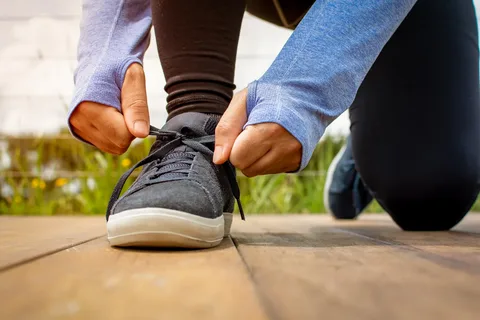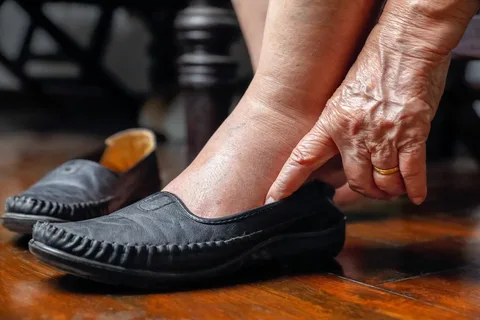As someone living with diabetes, it is important to take extra steps to protect your feet. One of the best ways to do this is to wear proper shoes. Shoes for diabetes provide special comfort and support that can help reduce the risk of foot complications. They also provide cushioning and shock absorption to help alleviate stress on your feet. In this blog post, we will explore the importance of diabetic shoes and how they can help you protect your feet.
What Is Diabetes And Why Are Shoes Important For People With Diabetes?
Diabetes is a chronic condition that affects how your body processes blood sugar. When you have diabetes, your body either does not produce enough insulin or cannot effectively use the insulin it produces. This leads to high blood sugar levels, which can cause various complications throughout the body.
One area that is particularly vulnerable to diabetes-related complications is the feet. High blood sugar can damage the nerves in your feet, a condition known as peripheral neuropathy. This can result in numbness or a loss of sensation, making it difficult to detect injuries or wounds. Additionally, poor circulation can impair the body’s ability to heal, increasing the risk of infections.
This is where proper diabetic shoes come in. Designed for the specific needs of people with diabetes, these shoes provide superior comfort, support, and protection. They have features such as extra cushioning, shock absorption, and wider toe boxes to reduce pressure and minimize the risk of ulcers, blisters, and calluses.
Causes & Symptoms of Diabetes
Diabetes is a complex chronic condition that affects millions of people worldwide. It occurs when the body either does not produce enough insulin or cannot effectively use the insulin it produces. There are several causes of diabetes, including genetics, obesity, and an unhealthy lifestyle. Certain risk factors, such as age and ethnicity, also play a role in developing this condition. The symptoms of diabetes can vary, but common signs include frequent urination, excessive thirst, unexplained weight loss, and fatigue.
People with diabetes may also experience blurry vision, slow-healing wounds, and frequent infections. These symptoms can significantly impact daily life and overall well-being. Understanding the causes and symptoms of diabetes is essential for early detection and effective management. By being aware of the warning signs, individuals can seek medical attention and take steps to prevent complications.
How Diabetes Affects the Feet and Why Foot Protection Is Crucial
Diabetes can have a significant impact on the health of your feet. High blood sugar levels can damage the nerves in your feet, leading to peripheral neuropathy. This can result in numbness or a loss of sensation, making it difficult to detect injuries or wounds. Additionally, poor circulation caused by diabetes can impair the body’s ability to heal, increasing the risk of infections.
Foot ulcers and non-healing wounds are common complications that can lead to serious problems, such as amputations. This is why foot protection is crucial for individuals with diabetes. Wearing proper diabetic shoes can help reduce the risk of foot complications by providing support, cushioning, and reducing pressure on the feet.
 What to Look For In Diabetic Shoes
What to Look For In Diabetic Shoes
When it comes to selecting diabetic shoes, there are a few key factors to consider. First and foremost, look for shoes that provide excellent support and cushioning. Diabetic shoes often have extra padding and shock absorption to protect your feet from pressure and impact. They should also have a wide toe box to accommodate any foot deformities or swelling that may occur.
In addition to comfort, consider the materials and construction of the shoes. Opt for breathable materials that allow air circulation to prevent moisture build-up and reduce the risk of infections. Look for shoes with adjustable closures, such as Velcro or laces, to ensure a proper fit that can accommodate any changes in foot size.
Finally, it is important to choose shoes that are specifically designed for people with diabetes. These shoes undergo rigorous testing and meet certain standards to ensure their effectiveness in preventing foot complications. Look for shoes that are labelled as “diabetic-friendly” or have been approved by healthcare professionals.
Different Types of Diabetic Shoes
When it comes to choosing diabetic shoes, a variety of options are available to suit your specific needs. One type of diabetic shoe is the therapeutic shoe, designed to provide maximum support and protection. These shoes often have features like extra depth, removable insoles, and wider toe boxes to accommodate foot deformities or swelling. Another type of diabetic shoe is the diabetic walking shoe, designed for more active individuals.
These shoes offer excellent cushioning, shock absorption, and a durable outsole for added stability. There are also diabetic sandals and slippers available for those looking for more breathable options during warmer months. No matter your lifestyle or preferences, there is a diabetic shoe out there for you. Remember, finding the right diabetic shoe is crucial for maintaining optimal foot health and reducing the risk of complications.
Tips for Selecting the Right Shoes for Diabetes
When selecting the right shoes for diabetes, remember a few key tips. First and foremost, prioritize comfort and support. Look for shoes that have extra cushioning and shock absorption to protect your feet from pressure and impact. A wide toe box is also important to accommodate any foot deformities or swelling. Next, consider the materials and construction of the shoes. Opt for breathable materials that allow air circulation and reduce the risk of infections.
Adjustable closures, such as Velcro or laces, are crucial to ensure a proper fit as foot sizes may change over time. It’s also important to choose shoes specifically designed for people with diabetes. Look for shoes that are labelled as “diabetic-friendly” or have been approved by healthcare professionals. These shoes have undergone rigorous testing to ensure their effectiveness in preventing foot complications.
Additional Foot Care Tips for Diabetics
Taking care of your feet is crucial when you have diabetes. In addition to wearing proper shoes, several other foot care tips can help you prevent complications. Firstly, it’s important to keep your feet clean and dry. Wash them daily with warm water and mild soap, making sure to dry them thoroughly, especially between the toes. Moisturize your feet regularly with a diabetic-friendly foot cream or lotion, but avoid applying it between the toes to prevent fungal infections.
Additionally, regularly inspect your feet for any cuts, sores, or signs of infection. If you notice anything unusual, seek medical attention immediately. Proper toenail care is also important – trim your toenails straight across and avoid cutting them too short. Finally, maintaining good blood sugar control is essential, as high blood sugar levels can impair circulation and increase the risk of complications. Following these additional foot care tips can protect your feet and reduce the risk of diabetes-related foot problems.
Preventing Foot Injuries and Complications in Diabetes Patients
Preventing foot injuries and complications is crucial for individuals with diabetes. Due to the nerve damage and poor circulation associated with diabetes, even small injuries can quickly escalate into serious problems. To avoid these complications, it is important to take proactive measures. First and foremost, examine your feet daily for any signs of injury or infection. See medical attention immediately if you notice any redness, swelling, cuts, or sores.
Regularly trim your toenails straight across, taking care not to cut them too short to avoid ingrown toenails. Keep your feet clean and dry, and moisturize them regularly with a diabetic-friendly lotion to prevent dryness and cracking. Proper footwear is essential for preventing foot injuries. Invest in high-quality diabetic shoes that provide support, cushioning, and protection. Avoid walking barefoot or wearing tight shoes that can increase pressure on your feet.
Wear socks made from moisture-wicking materials to keep your feet dry and prevent fungal infections. Lastly, maintaining good blood sugar control is key. By managing your blood sugar levels, you can reduce the risk of complications and promote overall foot health. Follow your healthcare provider’s instructions for managing your diabetes and take any prescribed medications as directed.
FAQ’s
1. Are diabetic shoes covered by insurance?
Yes, in many cases, diabetic shoes are covered by insurance. Medicare, for example, provides coverage for diabetic shoes if certain criteria are met. It’s important to check with your insurance provider to understand the specific requirements and coverage options available to you.
2. Can I wear regular shoes if I have diabetes?
While it is possible to wear regular shoes if you have diabetes, it is highly recommended to wear shoes specifically designed for people with diabetes. Regular shoes may not provide the support and cushioning needed to protect your feet. Diabetic shoes offer extra comfort and protection to minimize the risk of foot complications.
3. How often should I replace my diabetic shoes?
The lifespan of diabetic shoes can vary depending on factors such as usage and wear. As a general guideline, it is recommended to replace your diabetic shoes every 6-12 months or as advised by your healthcare professional. Regularly inspect your shoes for any signs of wear or damage and replace them when necessary.
4. Can I wash my shoes for diabetes?
Most shoes for diabetes can be cleaned and maintained like regular shoes. However, it’s important to follow the manufacturer’s specific care instructions. Some diabetic shoes may be machine washable, while others require hand cleaning. Always refer to the manufacturer’s guidelines to ensure proper care and maintenance of your diabetic shoes.
Conclusion
In conclusion, proper diabetic shoes play a vital role in protecting your feet and reducing the risk of complications. These shoes provide the necessary comfort, support, and cushioning to alleviate stress on your feet. By wearing diabetic shoes, you can minimize the risk of foot ulcers, blisters, and calluses. Additionally, following proper foot care tips, such as keeping your feet clean and dry and regularly inspecting them for any signs of injury or infection, can further prevent complications. Caring for your feet is essential for overall well-being when living with diabetes.
| Other Good Articles to Read |
| Skank Blogs |
| Unreal Blogs |
| Tba Blogs |
| All City Forums |
| Dany Blogs |
| Refuge Blogs |
| The Music Blogs |
| Key Forums |
| The Big Blog Theory |
| Joe Blogs |
| Blogs 4 Me |
| Blogs Emon |



